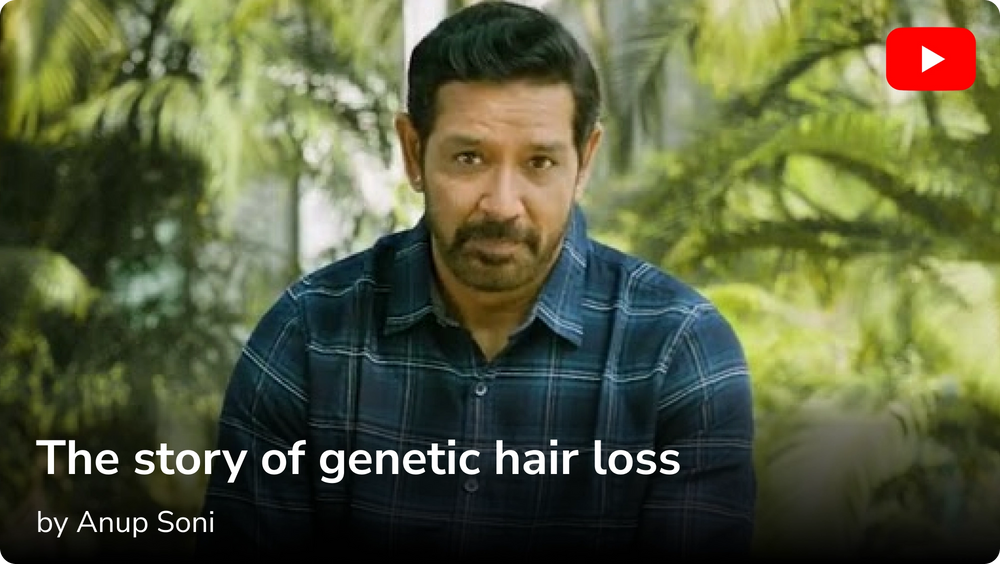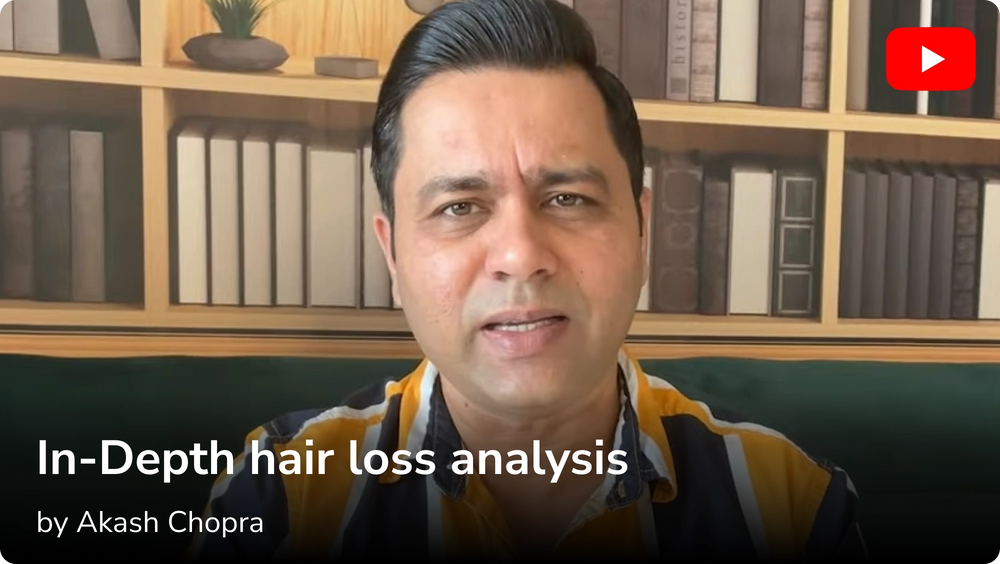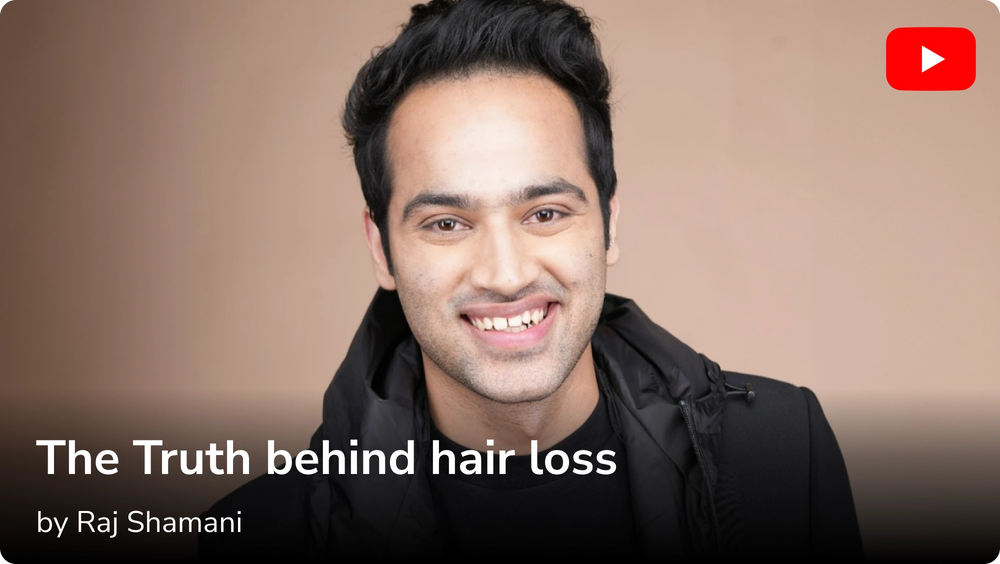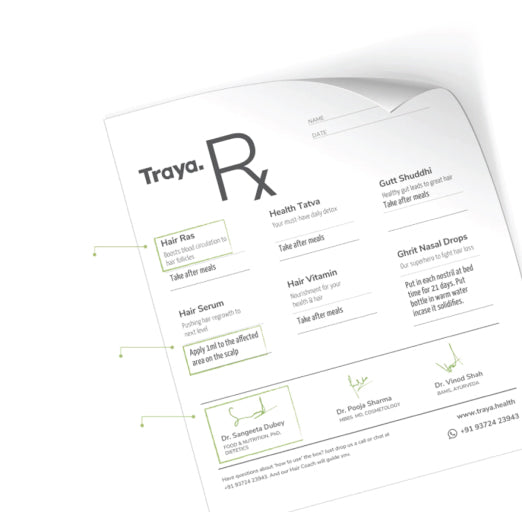क्या आप जानते हैं कि Hair spa benefits in Hindi क्या हैं? क्या आपको पता है कि हेयर स्पा की मदद से आप कई बालों की समस्या से छुटकारा पा सकते हैं? जी हां, इसकी मदद से न सिर्फ आपके बाल सिल्की और मजबूत बनते हैं बल्कि सही ढंग से हेयर स्पा कराने पर दो मुन्हे बाल, बालों में डेंड्रफ, झड़ते बालों आदि से भी छुटकारा पाया जा सकता है। आज के इस ब्लॉग में हम विस्तार से इसी विषय पर आपको जानकारी देंगे।
Hair Spa के लिए आपके पास आमतौर पर दो विकल्प होते हैं, पहला होता है प्राकृतिक और दूसरा होता है प्रोडक्ट्स। यानी आप प्रकृति में पाए जाने वाले संसाधनों की मदद से घर पर ही हेयर स्पा सोल्यूशन तैयार करके अप्लाई कर सकते हैं तो वहीं मार्केट में भी आपको अच्छे उत्पाद मिल जाते हैं। इन दोनों पर भी आपको विस्तार से जानकारी दी जाएगी। तो चलिए विस्तार से hair spa benefits in Hindi के साथ ही अन्य कई संबंधित विषयों पर बात करते हैं।
लेकिन, क्या आप जानते हैं कि हेयर स्पा तभी सबसे ज्यादा प्रभावी होगा जब आप अपने बालों की असली समस्या को समझें? अगर आपके बालों की समस्याओं का कारण कुछ और है, तो सिर्फ हेयर स्पा करना काफी नहीं होगा। इसलिए हम आपको Free Hair Test लेने की सलाह देते हैं। यह टेस्ट बिल्कुल फ्री है और इसे आप घर बैठे केवल 2 मिनट में कर सकते हैं। इस टेस्ट से आपको अपने बालों की समस्याओं का सही कारण पता चलेगा, जिससे आप सही उपचार की शुरुआत कर सकें।
मुफ़्त में अपने बालों का परीक्षण करें ⬇️
हेयर स्पा क्या है (What is Hair Spa)
हेयर स्पा बालों के लिए तैयार किया गया एक उपचार है जिसकी मदद से बालों को जरूरी पोषण प्रदान किया जाता है ताकि वे सिल्की, मजबूत और चमकदार बनें। हेयर स्पा में आमतौर पर तेल, कंडीशनर और हेयर मास्क का इस्तेमाल किया जाता है। इसे आमतौर पर एक या दो महीने में एक बार करवाया जाता है।
हेयर स्पा प्रक्रिया में कुछ सरल चरण हैं। सबसे पहले, गंदगी, तेल और किसी भी बचे हुए बाल उत्पादों को हटाने के लिए आपकी खोपड़ी को गहराई से साफ किया जाता है। यह सुनिश्चित करता है कि आपकी खोपड़ी ताजा और कुछ भी है जो बालों के विकास को अवरुद्ध करती है। अगला, आपकी खोपड़ी धीरे से मालिश की जाती है। यह कदम बहुत महत्वपूर्ण है क्योंकि यह आपके बालों की जड़ों में रक्त का प्रवाह बढ़ाता है, जो आपके बालों को बेहतर बढ़ने में मदद करता है और आपको आराम महसूस करने में भी मदद करता है।
मालिश के बाद, आपके बालों को भाप दिया जाता है। यह भाप आपकी खोपड़ी पर छिद्रों को खोलती है ताकि हेयर मास्क से पोषक तत्व जड़ों में गहरे जा सकें। अंतिम चरण एक पौष्टिक हेयर मास्क लगा रहा है। यह मुखौटा नमी लाता है और वापस सूखे या क्षतिग्रस्त बालों को चमकता है और आपके बालों को इसकी ज़रूरत की ताकत देता है।
आगे बढ़ने से पहले हम आपको बताते चलें कि Hair spa एक परमानेंट समाधान नहीं है। अगर आप स्पा कराती हैं तो आपके बालों पर इसका असर ज्यादा से ज्यादा एक महीने तक के लिए ही रहेगा। ऐसे में आपको बार बार स्पा कराती हैं तो न सिर्फ आपके पैसे खर्च होंगे बल्कि झड़ते बालों या बालों के विकास न होने की समस्या भी हल नहीं होगी। इसलिए हम आपको Traya Hair Test रिकमेंड करते हैं जोकि बिलकुल मुफ्त है।
इस टेस्ट की मदद से न सिर्फ आप यह जानते हैं कि hairfall का कारण क्या है बल्कि इस समस्या के समाधान के लिए आपको मुफ्त कंसल्टेशन भी दी जाती है। इसके बाद आप हमारे द्वारा सुझाया गया ट्रीटमेंट प्लान शुरू कर सकते हैं जिसकी मदद से आप भी हजारों हैप्पी कस्टमर्स की ही तरह अपने बालों का झड़ना भी रोक सकते हैं और नए बाल उगाने की प्रक्रिया शुरू कर सकते हैं।
ग्राहक का अनुभव:

हेयर स्पा के फायदे (Hair spa benefits in Hindi)
आपने ऊपर जाना कि हेयर स्पा क्या होता है, अब आइए विस्तारपूर्वक जानते हैं कि Hair spa benefits in Hindi क्या हैं। इसके पश्चात, हम आपको हेयर स्पा की विधि की भी पूरी जानकारी देंगे।
1. बालों का झड़ना कम होता है
भारत में एक बड़ी आबादी तेजी से बाल झड़ने की समस्या से जूझ रही है। ऐसे में अगर आप अपने बालों पर हेयर स्पा करवाती हैं तो बालों के टूटने की समस्या कम हो सकती है। इसका कारण है हेयर स्पा के दौरान इस्तेमाल होने वाले उत्पाद जो बालों को नमी देते हैं और साथ ही आवश्यक पोषण भी प्रदान करते हैं। जब बालों को हेयर स्पा के दौरान moisturiser mask से उपचार दिया जाता है हो बालों को पोषण मिलता है।
इसके अतिरिक्त, स्पा के दौरान दी गई कोमल मालिश खोपड़ी में रक्त परिसंचरण में सुधार करती है। बेहतर रक्त प्रवाह का मतलब है कि अधिक ऑक्सीजन और पोषक तत्व बालों के रोम तक पहुंचते हैं, जड़ों को मजबूत करते हैं और समय के साथ बालों के झड़ने को कम करने में मदद करते हैं।
बालों को आवश्यक पोषण मिलने की वजह से बाल मजबूत बनते हैं और उनका टूटना बंद हो जाता है। साथ ही, हेयर स्पा के दौरान स्कैल्प की अच्छे से मालिश भी की जाती है। इससे स्कैल्प में रक्त प्रवाह बढ़ता है जिससे बालों के रोम मजबूत बनते हैं। लेकिन यह समस्या सिर्फ एक से दो महीने के लिए ही बंद हो सकती है इसलिए परमानेंट समाधान के लिए हम आपको Traya Free Hair Test देने की सलाह देते हैं जिससे बालों का झड़ना और नए बालों का न उगने की समस्या हमेशा हमेशा के लिए दूर हो जाती है।
2. डैंड्रफ की समस्या को दूर करता है (Hair spa removes the problem of dandruff)
अगर आप डैंड्रफ रूसी की समस्या से जूझ रहे हैं तो हेयर स्पा करवाना आपकी इस समस्या को दूर करने में मदद कर सकता है। हेयर स्पा न सिर्फ बालों को रेशमी और स्टाइल करता है बल्कि डैंड्रफ की समस्या को दूर करने में भी प्रभावी माना गया है। Hair Spa के दौरान बालों पर हेयर मास्क लगाकर उसका उपचार किया जाता है, इससे बाल मुलायम बनते हैं और सिर की त्वचा पर मौजूद अशुद्धियों को दूर करते हैं।
क्या आप जानते हैं कि हवा में प्रदूषण और धूल भी रूसी का कारण बन सकती है या बढ़ सकती है? यह सच है हर बार जब आप बाहर जाते हैं, तो आपकी खोपड़ी पर्यावरण से छोटे कणों को इकट्ठा करती है। ये छिद्रों को बंद कर सकते हैं, आपकी खोपड़ी को सूख सकते हैं, या इसे तैलीय बना सकते हैं, दोनों से रूसी हो सकती है।
एक हेयर स्पा सिर्फ आपकी खोपड़ी को साफ नहीं करता है; यह एक प्रकाश, सुरक्षात्मक परत भी बनाता है। यह नमी में ताला लगाने में मदद करता है और हानिकारक कणों को दूर रखता है। जब आपकी खोपड़ी साफ और शांत होती है, तो डैंड्रफ को वापस आना मुश्किल होता है।
इसके अलावा, इस विधि के दौरान बालों की मालिश भी की जाती है जिससे रक्त प्रवाह बढ़ जाता है और डैंड्रफ के कारण होने वाली सूजन से भी राहत मिलती है। हेयर स्पा के दौरान इस्तेमाल होने वाले उत्पादों में एंटी डैंड्रफ और एंटी ऑक्सीडेंट गुण पाए जाते हैं जो रूसी का खात्मा करते हैं और साथ ही, इसके दोबारा पनपने की संभावना को भी कम करते हैं।
3. बालों को मॉइश्चराइज रखता है (Hair spa keeps hair moisturized)
बालों को मॉइश्चराइज रखने के लिए भी हेयर स्पा काफी फायदेमंद है। जब बाल मॉइश्चराइज नहीं होते हैं तो वे बेजान दिखने लगते हैं, दुमुंहे बाल की समस्या हो जाती है, रूसी का खतरा बढ़ जाता है और साथ ही बालों का तेजी से टूटना भी शुरू हो जाता है। ऐसे में दो महीने में 1 बार हेयर स्पा करवाना आपके बालों को लंबे समय तक मॉइश्चराइज रखता है और उन्हें बालों से संबंधित कई समस्याओं से छुटकारा दिलाता है।
जब आपकी स्कैल्प सूखी या परतदार होती है, तो यह स्वस्थ बालों का समर्थन नहीं कर सकता है। एक अच्छे स्पा सत्र में एक आरामदायक मालिश और भाप शामिल है, जो आपकी स्कैल्प को नमी को बेहतर ढंग से अवशोषित करने में मदद करता है। यह न केवल आपकी जड़ों को हाइड्रेट करता है, बल्कि रक्त प्रवाह में भी सुधार करता है, जिससे आपके बालों को अंदर से स्वस्थ हो जाता है।
अगर आप घर पर ही हेयर स्पा करने का विचार कर रही हैं तो अन्य पदार्थों के साथ ही, नारियल तेल या नारियल दूध का इस्तेमाल जरूर करें। इससे बालों को मॉइश्चराइज रखने में मदद मिलती है। तो इस तरह hair spa benefits in Hindi सिर्फ डैंड्रफ के लिए ही नहीं बल्कि बालों को मॉइश्चराइज रखने के लिए भी है। ध्यान दें कि हेयर स्पा से बालों को moisturise सिर्फ एक या अधिकतम दो महीनों के लिए ही मिलता है इसलिए हम आपको Traya Free Hair Test की सलाह देते हैं जो बालों को नमी प्रदान करने और बालों का झड़ना रोकने का परमानेंट समाधान है।
मुफ़्त में अपने बालों का परीक्षण करें ⬇️
Also Read: पतले बालों को घना और सेहतमंद बनाने की आसान टिप्स
4. हेयर स्पा से बाल घना बनते हैं (Hair spa makes hair thick)
घने लम्बे बाल हर महिला की चाहत होती है जिसके लिए न जाने कितने ही यत्न किए जाते हैं। लेकिन दो महीने में एक बार हेयर स्पा बालों को घना और खूबसूरत बनाता है। बालों के घना बनाने में दो मुख्य बातें होती हैं: पहला बालों का टूटना बंद होना और दूसरा बालों का तेजी से विकास। अगर ये दोनों बातें साथ साथ हों तो बाल ज्यादा घने और खूबसूरत बनते हैं जिससे पर्सनेलिटी को चार चांद लग जाते हैं।
क्या आप जानते हैं? नियमित हीट स्टाइल, प्रदूषण और तनाव आपके बालों को धीरे -धीरे पतला कर सकते हैं, यहां तक कि आपको इसका एहसास भी नहीं है। हेयर स्पा एक रीसेट के रूप में काम करता है, यह मरम्मत, पुनर्स्थापित करता है और बेहतर बालों के विकास को प्रोत्साहित करता है।
यदि आपको लगता है कि आपके बाल पतले हो रहे हैं या सपाट दिख रहे हैं, तो हर 4 से 6 सप्ताह में हेयर स्पा के लिए जाने की कोशिश करें। और दीर्घकालिक परिणामों के लिए, यह भी पता लगाना एक अच्छा विचार है कि आपके बालों को वास्तव में क्या चाहिए। ट्रेया का मुफ्त हेयर टेस्ट आपको अपने खोपड़ी के स्वास्थ्य को समझने में मदद करता है और स्वस्थ, मोटे बालों के विकास का समर्थन करने के लिए एक व्यक्तिगत योजना प्रदान करता है।
जब आप हेयर स्पा करवाती हैं तो उसमें मौजूद ढेरों पोषक तत्व जैसे विटामिंस, प्रोटीन, मिनरल्स आदि आपके बालों को सही पोषण देते हैं जिससे उनका टूटना कम हो जाता है। साथ ही मालिश और मॉइश्चराइज करने की प्रक्रिया से बालों की जड़ों तक रक्त प्रवाह बेहतर होता है जिससे बालों का विकास सही से होता है। इस तरह आप बालों को आसानी से घना बना पाते हैं।
5. बालों को स्टाइल करना आसान हो जाता है (Styling hair becomes easier)
हेयर स्पा का मुख्य उद्देश्य ही बालों की स्टाइलिंग होती है और सबसे अच्छी बात यह है कि इससे बालों को आसानी से स्टाइल किया जा सकता है। जब Hair spa की प्रक्रिया के दौरान बालों को अच्छे से उपचार दिया जाता है तो वे ज्यादा मुलायम, सिल्की और चमकदार बन जाते हैं। साथ ही उनमें लचीलापन भी आ जाता है। इससे आप आसानी से बालों को जैसे चाहें वैसे स्टाइल कर सकती हैं।
हेयर स्टाइल के बाद बालों का टूटना और फ्रिज होने की संभावना में कमी आती है। अब अगर आप अपने बालों को स्ट्रेट करना, कर्ल करना, या अन्य स्टाइल करना चाहती हैं तो बड़ी ही आसानी से कर सकती हैं। तो इस तरह अगर आप अपने बालों को स्टाइल करवाना चाहती हैं तो hair spa ke fayde उठा सकती हैं। हालांकि बालों को स्टाइलिंग करवाते वक्त अत्यधिक गर्मी वाले उत्पादों से दूरी बनानी चाहिए क्योंकि इससे बालों का टूटना शुरू हो जाता है।
6. बालों को चमकदार बनाता है (Makes hair shiny)
अगर आपके बाल सूखे और बेजान नजर आते हैं तो हेयर स्पा की मदद से आप अपने बालों को चमकदार बना सकते हैं। रूखे बाल देखने में ख़राब लगते हैं और साथ ही उनके टूटने की सम्भावना भी अधिक होती है। स्पा के दौरान ऐसे उत्पादों और प्राकृतिक संसाधनों का बालों पर इस्तेमाल किया जाता है जिससे बालों में नमी आती है, बालों को आवश्यक पोषक तत्व प्राप्त होते हैं। जब बाल स्वस्थ और मजबूत बनते हैं तो स्वतः ही उनमें चमक आ जाती है।
लेकिन जैसा कि हमने आपको पहले ही बताया, हेयर स्पा करवाने से आपके बालों में स्थायी चमक नहीं आएगी। इसके लिए आपको हम सुझाव देते हैं कि Traya Free Hair Test दें, इस टेस्ट से आपके बेजान और झाड़ते बालों की समस्या का कारण पता लगाया जाता है और कारण के हिसाब से ही ट्रीटमेंट शुरू की जाती है। इससे बालों को आवश्यक पोषक तत्त्व भी मिलते हैं और बाल चमकदार बनते हैं।

Types of Hair Spa in Hindi (हेयर स्पा के प्रकार)
आपने ऊपर विस्तार से जाना कि Hair spa benefits in Hindi क्या है।आइए अब जानते हैं कि हेयर स्पा के प्रकार कितने होते हैं। बालों की अलग अलग समस्याओं और आपकी अलग अलग जरूरतों के हिसाब से ही हेयर स्पा के प्रकार भी अलग अलग होते हैं। आइए एक नजर डालते हैं उन विभिन्न हेयर स्पा के तरीकों पर:
1. Dry Hair Spa
सबसे पहले हम बात करेंगे Dry Hair Spa के बारे में। इस प्रकार का हेयर स्पा आमतौर पर वे लोग करवाते हैं जिनके बाल रूखे और बेजान होते हैं। अगर आपके बाल भी रूखे और बेजान हो गए हैं तो यह स्पा आप करवाकर बालों में वापस से जान डाल सकती हैं। इस स्पा से बालों को नमी मिलती है और साथ ही बाल मॉइश्चराइज होते हैं जोकि बालों को मुलायम और चमकदार बनाता है।
आमतौर पर, इस प्रकार के उपचार में प्राकृतिक तेल, कुछ पौधों के अर्क और अन्य कई पोषक तत्वों से युक्त एक मॉइश्चराइज मास्क तैयार किया जाता है। जब आप किसी प्रोफेशनल की मदद लेते हैं तो उनके पास पहले से ही ऐसे उत्पाद मौजूद होते हैं जो आपके बेजान बालों में जान डाल दें।
Also Read: कैस्टर ऑयल के फायदे और नुकसान
2. Oily Hair Spa
दूसरे स्थान पर है Oily Hair Spa जिसका इस्तेमाल उनपर किया जाता है जिनके बाल तैलीय होते हैं। अगर आप भी तैलीय चिपचिपे बालों से परेशान हैं तो इस प्रकार के हेयर स्पा की मदद ले सकते हैं। इस उपचार विधि में आपके बालों पर शैंपू और डीप कंडीशनर का इस्तेमाल किया जाता है और गहराई से आपके बालों की सफाई की जाती है।
इस प्रक्रिया में आपके सिर की त्वचा पर मौजूद तेल को हटाने में मदद मिलती है और साथ ही, स्कैल्प की भी सफाई होती है। घर पर भी आप इस तरह के हेयर स्पा को बड़े ही आसानी से तैयार कर सकते हैं जिसकी जानकारी आपको आगे दी जाएगी।
3. Dandruff Hair Spa
अगर आप डैंड्रफ का रामबाण इलाज तलाश रहे हैं और आपको कोई भी समाधान नहीं मिल रहा है तो आप डैंड्रफ हेयर स्पा की मदद ले सकती हैं। बालों में डेंड्रफ होना एक आम समस्या है जिससे एक बड़ी आबादी परेशान है। लेकिन घरेलू उपचारों के अतिरिक्त आप हेयर स्पा की मदद से भी बालों में मौजूद डैंड्रफ को आसानी से दूर कर सकते हैं।
इस स्पा में बालों की अच्छे से मालिश की जाती है ताकि सिर की त्वचा में रक्त प्रवाह बेहतर बने और साथ ही बालों को सही पोषण प्रदान किया जा सके। मालिश के साथ ही, बालों को एंटी-फंगल और एंटी-इंफ्लेमेटरी उपचार भी दिया जाता है जोकि डैंड्रफ को दूर भगाने में सहायक होता है। दो महीने में एक बार अगर आप इस स्पा को करवाती हैं तो अवश्य ही डैंड्रफ की समस्या में कमी आयेगी।
4. Damage hair spa
क्या आप अपने बालों पर हिट स्टाइलिंग, ब्लीचिंग और अन्य उपचारों का इस्तेमाल करती हैं? क्या आपके बाल इन उपचारों की वजह से डैमेज हो गए हैं और बेजान दिखते हैं? अगर आपका उत्तर है हां तो आप Damage hair spa करवा सकती हैं जिससे डैमेज्ड बालों की समस्या दूर होती है और इनमें फिर से जान आ जाती है। इससे बाल मजबूत और स्वस्थ भी बनते हैं।
इस तरह के स्पा में बालों में प्राकृतिक तेल, प्रोटीन और अन्य पोषक तत्व से युक्त उपचार दिया जाता है। इस उपचार को बालों पर इस्तेमाल करके से न सिर्फ उनमें ताजगी आती है बल्कि वे स्वस्थ और मजबूत भी बनते हैं।
5. Colour protection spa
आखिरी स्पा प्रकार है Colour protection spa जिसे आमतौर पर वे लोग करवाते हैं जो अपने बालों को रंग करवाते हैं पर उससे होने वाले नुकसान से बचना चाहते हैं। वर्तमान समय में लोग अपने बालों को स्टाइल देने या आकर्षक लुक देने के लिए रंग का इस्तेमाल करते हैं। पुरुष और महिला दोनों समान रूप से बालों को रंग करवाते हैं लेकिन इससे जहां एक तरफ बाल स्टाइलिश दिखते हैं तो वहीं बालों को नुकसान भी हो जाता है जिससे उनके टूटने का खतरा बढ़ जाता है।
इस परिस्थिति में आप Colour protection spa की मदद ले सकती हैं। इससे आपके बाल हमेशा मुलायम रहते हैं और मजबूत भी बनते हैं और बालों में कलर करवाने की वजह से जो क्षति हुई होती है, वह भी दूर हो जाती है। अगर आप अक्सर बालों को रंग करवाते हैं तो आपको कम अवधि में ही हेयर स्पा करवाना चाहिए।
हेयर स्पा घर पर तैयार करने की विधि (How to prepare hair spa at home)
आपने ऊपर विस्तारपूर्वक जाना कि Hair spa ke fayde क्या हैं, लेकिन उन फायदों को प्राप्त करने के लिए आपको हजारों रुपए खर्च करने की आवश्यकता नहीं है। बल्कि आप घर बैठे भी बिना ढेरों रुपए खर्च किए हेयर स्पा कीट या ट्रीटमेंट को तैयार कर सकती हैं। इसे तैयार करने के लिए आपको कहीं और जाने की आवश्यकता भी नहीं पड़ेगी, बल्कि ये सभी सामग्रियां आपको घर में ही उपलब्ध हो जाएंगी।
तो आइए जानते हैं कि हेयर स्पा ट्रीटमेंट घर पर कैसे तैयार करें, इसकी पूरी विधि क्या है। आप चाहें तो Hair spa treatment at home विडियो भी देख सकते हैं।
सामग्री
- नारियल का तेल
- बादाम का तेल
- एलोवेरा जेल
- दही
- शहद
- अंडे की जर्दी
- बेकिंग सोडा
- ओट्स
- नीम का तेल
- टी ट्री ऑयल
विधि
- सबसे पहले अपने बालों को अच्छे से धो लें
- इसके पश्चात सभी सामग्रियों को अच्छे से एक कटोरी में मिला लें, मात्रा जरूरत के अनुसार ही रखें
- मिश्रण कुछ ऐसा होना चाहिए कि यह मास्क की तरह लगे, आप मिक्सर ग्राइंडर में इन्हें डालकर पेस्ट तैयार कर सकती हैं
- अब आपको इन सामग्रियों को अपने बालों पर और सिर की त्वचा में अच्छे से लगाना है
- इसके पश्चात मास्क को लगभग एक घंटे तक के लिए बालों पर यूंही रहने दें, आप तौलिए से बाल को लपेट भी सकते हैं
- अंत में बालों को कंडीशनर या शैंपू की मदद से धो लें
तो इस तरह आप घर बैठे ही ऊपर दी गई सामग्रियों की मदद से अपने बालों के लिए हेयर स्पा तैयार कर सकती हैं। इस मिश्रण को बालों पर लगाने से आपको सभी Hair spa benefits in Hindi मिलेंगे।
क्या हेयर स्पा बालों की समस्याओं के लिए असली समाधान है?
अगर सच्चाई की बात करे तो, एक हेयर स्पा प्राप्त करना बहुत अच्छा लगता है। यह आपको आराम देता है, आपके बालों को नरम बनाता है, और आपकी खोपड़ी को कुछ बहुत जरूरी देखभाल देता है। लेकिन अगर आपके बाल गिर रहे हैं, पतले हो रहे हैं, या बिल्कुल नहीं बढ़ रहे हैं, तो एक हेयर स्पा केवल आपको अस्थायी राहत दे सकता है, न कि एक वास्तविक समाधान।
बालों की समस्याएं आमतौर पर तनाव, खराब पोषण, हार्मोनल असंतुलन या अन्य स्वास्थ्य मुद्दों के कारण शरीर के अंदर से शुरू होती हैं। एक स्पा सतह पर मदद कर सकता है, लेकिन यह ठीक नहीं कर सकता है कि क्या चल रहा है।
यही कारण है कि आपके बालों के मुद्दों के मूल कारण को समझना महत्वपूर्ण है। ट्रेया का मुफ्त हेयर टेस्ट ठीक यही करता है। यह पता चलता है कि आपके बालों के स्वास्थ्य को वास्तव में क्या प्रभावित कर रहा है और आपको इसके भीतर से इलाज करने के लिए एक व्यक्तिगत योजना देता है।
बाल परीक्षण करें और पता करें कि क्या आपकी खोपड़ी को बस स्पा की जरूरत है या कुछ और गंभीर है।
हेयर स्पा में ध्यान रखने वाली बातें (Things to remember for Hair Spa)
अगर आप हेयर स्पा कराने जा रही हैं या घर पर ही हेयर स्पा करना चाहती हैं तो आपको कुछ जरूरी बातों का ध्यान रखना चाहिए। आइए जानते हैं कि आपको किन बातों का ध्यान रखना चाहिए:
1. हेयर स्पा प्रोफेशनल सही उपचार करें इसके लिए उन्हें अपने बालों की सही स्तिथि बताएं।
2. हेयर स्पा करवाने या करने से पहले अपने बालों को धोना भी जरूरी है।
3. हेयर स्पा प्रोफेशनल से उन्हीं उत्पादों का इस्तेमाल करने का सुझाव दें जो पैराबिन और सल्फेट फ्री हो।
4. हेयर स्पा के बाद अपने बालों को धोने के लिए हल्के शैंपू का इस्तेमाल करें।
5. हेयर स्पा के पश्चात आपको अपने बालों में हेयर ऑयल या सीरम लगाना चाहिए।
6. हेयर स्पा के तुरंत बाद धूप और प्रदूषण से बचने की कोशिश करें।
7. भारत में आपको एक हेयर स्पा के लिए ₹600 से लेकर ₹5000 तक खर्च करना पड़ सकता है, परन्तु यह कोई परमानेंट समाधान नहीं होगा।
तो ये कुछ बातें हैं जिन्हें आपको अवश्य ही ध्यान में रखना चाहिए। साथ ही, अगर आपको Hair Spa करवाते समय कोई एलर्जी होती है तो तुरंत इसके बारे में स्पा प्रोफेशनल को जानकारी दें।
हेयर स्पा के नुकसान (Disadvantages of hair spa)
हर सिक्के के दो पहलू होते हैं और इसलिए ही हेयर स्पा के फायदे और नुकसान दोनों हैं। जहां एक तरफ हेयर स्पा करने के फायदे यह है कि यह आपके बालों को स्टाइलिश, मजबूत और डैंड्रफ फ्री बनाता है तो वहीं इसके कुछ नुकसान भी हैं, जिसके बारे में आप नीचे पढ़ सकते हैं।
1. कुछ लोगों को एलर्जी हो सकती है
सबका शरीर अलग अलग है और इसलिए हर प्रक्रिया, उपचार या पदार्थ का प्रभाव भी सभी पर अलग अलग ही होता है। जहां अधिकतर लोगों को Hair spa benefits in Hindi मिलते हैं तो वहीं कुछ लोगों को इसकी वजह से एलर्जी भी हो जाती है। एलर्जी जैसे खुजली, अत्यधिक पसीना आना, झुंझलाहट और तनाव आदि जिसमें तुरंत ही स्पा प्रोफेशनल को इसकी जानकारी देनी चाहिए।
2. बालों का रंग हल्का पड़ सकता है
हेयर स्पा की वजह से आपके बालों का रंग भी हल्का पड़ सकता है। खासतौर पर अगर आप कठोर रसायनों से युक्त प्रोडक्ट्स और अत्यधिक गर्मी में बालों को स्टीम कराते हैं तो बालों का रंग फीका होने लगता है। इसके लिए आप अपने हेयर स्पा प्रोफेशनल को Traya products इस्तेमाल करने की सलाह दे सकते हैं जोकि न सिर्फ कठोर रसायनों से मुक्त होते हैं बल्कि आपके बालों के फायदे को ध्यान में रखकर ही तैयार किए गए हैं।
3. बाल झड़ना शुरू हो सकता है
कुछेक परिस्थितियों में हेयर स्पा की वजह से आपके बाल झड़ने भी शुरू हो सकते हैं। खासतौर पर अगर हेयर स्पा के दौरान ऐसे उत्पादों का इस्तेमाल किया गया हो जो कठोर रसायनों से बनें हों। साथ ही, अगर सिर की त्वचा पर मौजूद प्राकृतिक तेल की सफाई जरूरत से ज्यादा हो जाए तो नमी कम हो जाती है और इससे बाल कमजोर होकर टूटना शुरू हो सकते हैं।

हेयर स्पा के साइड इफ़ेक्ट – जाने से पहले जान लें
हालाँकि हेयर स्पा ट्रीटमेंट बहुत आरामदायक और मददगार हो सकते हैं, लेकिन ये सभी के लिए उपयुक्त नहीं होते हैं। कुछ मामलों में, अगर सावधानी से न किया जाए तो ये वास्तव में समस्याएँ पैदा कर सकते हैं।
तैलीय स्कैल्प वाले लोगों के लिए, स्पा ट्रीटमेंट के दौरान इस्तेमाल किए जाने वाले भारी हेयर मास्क एक अच्छा विचार नहीं हो सकता है। ये मास्क स्कैल्प को और भी ज़्यादा चिकना बना सकते हैं और रोमछिद्रों को बंद कर सकते हैं, जिससे रूसी या बालों से जुड़ी और भी समस्याएँ हो सकती हैं।
अगर आपकी त्वचा संवेदनशील है, तो स्पा में इस्तेमाल किए जाने वाले कुछ उत्पाद जलन या जलन पैदा कर सकते हैं। यह खास तौर पर तब सच होता है जब स्पा में केमिकल-आधारित उत्पादों का इस्तेमाल किया जाता है या इस्तेमाल से पहले उनका ठीक से परीक्षण नहीं किया जाता है।
बहुत बार हेयर स्पा करवाने से आपकी स्कैल्प पोषण के लिए बाहरी उत्पादों पर निर्भर हो सकती है। इसका मतलब है कि आपकी स्कैल्प अपने प्राकृतिक तेलों का उत्पादन बंद कर सकती है और आपको ऐसा लग सकता है कि नियमित स्पा ट्रीटमेंट के बिना आपके बाल बेजान या बेजान हो गए हैं।
एक और बात जिसका ध्यान रखना चाहिए वो है स्पा की गुणवत्ता। सस्ते सैलून कभी-कभी कम गुणवत्ता वाले या एक्सपायर हो चुके उत्पादों का इस्तेमाल करते हैं, जो आपके बालों को फ़ायदा पहुँचाने के बजाय उन्हें नुकसान पहुँचा सकते हैं।
आपको क्या सावधानियां बरतनी चाहिए:
हेयर स्पा करवाने से पहले हमेशा त्वचा पर एक छोटा सा पैच टेस्ट करवाएं ताकि किसी तरह की एलर्जी की जांच हो सके। और इसे ज़्यादा न करें - महीने में एक बार हेयर स्पा करवाना आमतौर पर आपके बालों को बिना किसी समस्या के स्वस्थ रखने के लिए पर्याप्त होता है।
निष्कर्ष (Conclusion)
अगर हम बात करें Hair spa benefits in Hindi की तो ये कई हैं जैसे बालों के झड़ने की समस्या से राहत मिलती है, डेंड्रफ का सफाया होता है, बाल मॉइश्चराइज होते हैं आदि लेकिन कुछ नुकसान भी हो सकते हैं जैसे एलर्जी, बालों की रंगत में कमी और कुछ परिस्थितियों में बालों का झड़ना।
अगर आप बिना रुपए खर्च किए हेयर स्पा करने के फायदे प्राप्त करना चाहते हैं तो इसे घर पर भी तैयार कर सकते हैं। दो महीने में आपको अधिकतम एक बार ही हेयर स्पा कराना चाहिए।
लेकिन ध्यान रखें कि यह कोई स्थायी समाधान नहीं है, स्थायी समाधान प्राप्त करने के लिए आपको Traya Hair Test देना चाहिए ताकि झड़ते बालों के सही कारणों का पता लगाकर उसका स्थायी इलाज शुरू किया जा सके। आप इस फ्री टेस्ट को देकर झड़ते बालों पर हमेशा हमेशा के लिए अंकुश लगाने का शुभारम्भ कर सकते हैं।
मुफ़्त में अपने बालों का परीक्षण करें ⬇️
अक्सर पूछे जाने वाले प्रश्न (Frequently Asked questions)
1. हेयर स्पा कितने दिन तक रहता है?
हेयर स्पा का इफेक्ट एक से दो महीने तक रहता है। अगर प्रभावी तरीके से हेयर स्पा किया गया है तो आप एक से दो महीने निश्चिंत रह सकते हैं। हर दो महीने में एक बार हेयर स्पा कराने का सुझाव दिया जाता है। परमानेंट समाधान के लिए Traya का हेयर टेस्ट दें जोकि फ्री है।
2. क्या हेयर स्पा से बाल घने होते हैं?
हेयर स्पा कराने से बालों में विकास होता है और साथ ही झड़ते बालों की समस्या भी कम हो जाती है। इस वजह से बाल ज्यादा घने, लंबे और चमकदार बन जाते हैं।
3. हेयर स्पा के बाद क्या नहीं करना चाहिए?
हेयर स्पा के बाद आपको धूप और प्रदूषण भरे माहौल में नहीं निकलना चाहिए। अगर जरूरी हो तो हमेशा स्कार्फ या टोपी पहन कर ही बाहर निकलें।
4. क्या हेयर स्पा के बाद शैंपू करना चाहिए?
जी हां, हेयर स्पा के बाद आपको शैंपू या कंडीशनर करना चाहिए। इससे बालों को ताजगी मिलती है और सिर की त्वचा पर मौजूद सभी अशुद्धियां बाहर निकल जाती हैं।
5. Hair spa se kya hota hai?
हेयर स्पा से बाल घने, मुलायम, मजबूत और चमकदार बनते हैं। इसके साथ ही, डेंड्रफ की समस्या से भी छुटकारा मिलता है।
References
- Surprising Hair Spa Benefits Which Will Make You Do It Everyday! - https://bebodywise.com/blog/hair-spa-benefits/
- Hair Spa: 5 Reasons You Should Try It - https://dayspaassociation.com/hair-spa-5-reasons-you-should-try-it/
- How To Do Hair Spa At Home & Its Benefits For Your Hair - Traya: https://traya.health/blogs/hair-care/how-to-do-hair-spa-at-home-its-benefits-for-your-hair


















